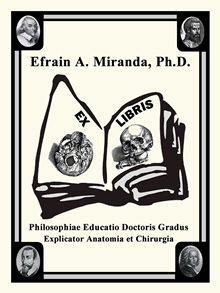UPDATED: After a long hiatus, I am happy to report that this website has been updated to a newer version of Joomla!, and still hosted by GoDaddy. The "look" of the website has not changed, but the software is faster and with a higher level of security. This work was done by my good friend from Greece, Christopher Mavros, who is an expert at designing web templates, web sites, and Joomla! extensions. This also meant that my library catalog was left unfinished for a long time and this required lots of additional work.
First, the library needed new and updated bookplates, which were printed by BookplateInk, a USA based company that I strongly recommend. In case anyone wonders, the famous anatomists that are depicted in the bookplate are Harvey, Vesalius, Spigelius, and Albinus. Second, I needed software that could create the code to publish the titles of the library online. This work was done by my daughter Evelyn, to whom I am deeply grateful.
Recataloging the library is an ongoing effort. This will also require repairing and rebinding some of the older and damaged books. Due to this, during the next weeks and months this listing will change, but for a bibliophile this is not work, but pleasure.
As many of you know I am a collector of old and antique medical and anatomy books and I also have several copies of some of these books in different languages.
The oldest book in the library dates from 1696 and is "Opera Chirurgica Anotomica Conformata al Moto Circolare Del Sangue, & Altre Inuenziono De'piu Moderni. Aggivuntovi Un Trattato Della Peste" by Paolo Barbette. I recently acquired the 1713 book by Aulus Cornelius Celsus "De Medicina, Libri Octo".
Another book I am very proud of is not old, but still a rare book. It is "The Fabric of the Human Body, An Annotated Translation of the 1543 and 1555 Editions of “De Humani Corporis Fabrica Libri Septem", by Drs. Garrison and Hast This monumental translation work took twenty years and only 948 copies of this book were published in 2014. Completely sold out, it is today a rare book!
There are many other books that are important to me, either by its rarity (for those who know.... "The Green Book") or its controversy, as are the books by Pernkopf and Stefano Mancini.
You are welcome to peruse my library catalog, but be forewarned; I am not selling any of my books. Should you want to find a copy, you can use Abebooks.com as a great source for old and new books.




